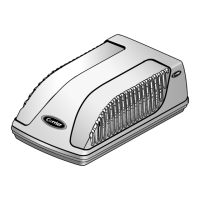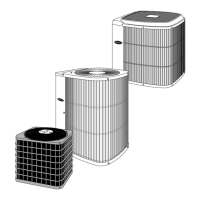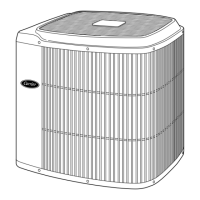19
Multitude of applications
These units can be floor or ceiling mounted, are available
with a variety of options that can meet the design require-
ments, and provide a low cost solution for a multitude of
applications.
Standard horizontal and vertical blower coil appli-
cations — Where the application calls for cooling capac-
ities or external static pressures that can not be met with
standard or high performance direct drive fan coil units,
use a Carrier standard horizontal or vertical blower coil.
Outside air applications — With the availability of
larger capacities, a variety of optional coils, mixing boxes,
and the capability of delivering air through long duct runs,
the belt drive units are ideal for handling outside air. When
used as outside air units, the heating coil should be in the
preheat location (consult Carrier’s application engineering
group).
Large public areas — These units are ideal for applica-
tions with a large common area such as restaurants, air-
ports, sports arenas, stadiums, private boxes, gymnasiums,
exercise areas, locker rooms, atriums and foyers, auditori-
ums, shopping malls, and casinos, to name a few.
Basic definitions
Unit hand — When facing the supply air outlet from the
front of the unit (air blowing in your face), your right hand
will be the right hand side of the unit and your left hand the
left hand side of the unit.
Seismic certification
An optional seismic structural upgrade is available. Car-
rier’s belt drive series fan coil units with the seismic struc-
tural upgrade option are independently tested and certified
in accordance with IBC-2009 and OSHPD ICC-ES-AS-
156 with SDS of 1.93.
Installation considerations
The belt drive units are typically either suspended above
the ceiling or installed in a closet or mechanical room.
Attention should be paid to having enough clearance
around the units for service and maintenance.
Horizontal units are generally suspended above the ceil-
ing using hanger rods that go through the corner knock-
outs provided in the units. External vibration isolation and
flex connections for ducts are recommended.
Vertical units are typically installed on a pad. Ensure
adequate pad height for proper trapping of the condensate
drain.
Acoustical considerations
With sound becoming more of a concern to design engi-
neers, building owners, and occupants, proper consider-
ation should be given to the selection and placement of
these units.
Whenever possible, avoid placing these units above an
occupied space. To further reduce the sound level, use
additional measures such as: using flexible duct connectors;
lining the main supply and return ducts with acoustical
absorption material; locating the return-air grilles as far
away from the unit as possible; and using three-phase
motors.
Operating limitations
The fan curves outline the airflow and static pressure range
where it is acceptable to run these units. Running the belt
drive units outside this range could lead to drastically
reduced bearing life and premature wheel failure. In cool-
ing applications, this could also result in moisture carry
over. In addition, running the fan at its maximum fan speed
will increase the power requirements and generate higher
sound levels.
On units with electric heat, the minimum airflow shown
on the fan curve must be maintained to prevent excessive
discharge temperature and electric heat safety trips. For
leaving discharge air temperatures greater than 104 F
(40 C), contact the applications engineering group.
Quality
Carrier's belt drive fan coil units are listed by Intertek Test-
ing Services (ITS). ITS's C-ETL-US listing signifies that
Carrier's belt drive fan coil units have been examined by
ITS and comply with the minimum requirements of U.S.
and Canadian national product safety standard, UL 1995/
CSA C22.2 No. 236, and that the manufacturing site has
been audited. ITS's re-examination service includes peri-
odic visits to the factory to ensure continued compliance
for all listed products.
Every unit is tested and inspected at the factory for trou-
ble-free start-up.
Application data

